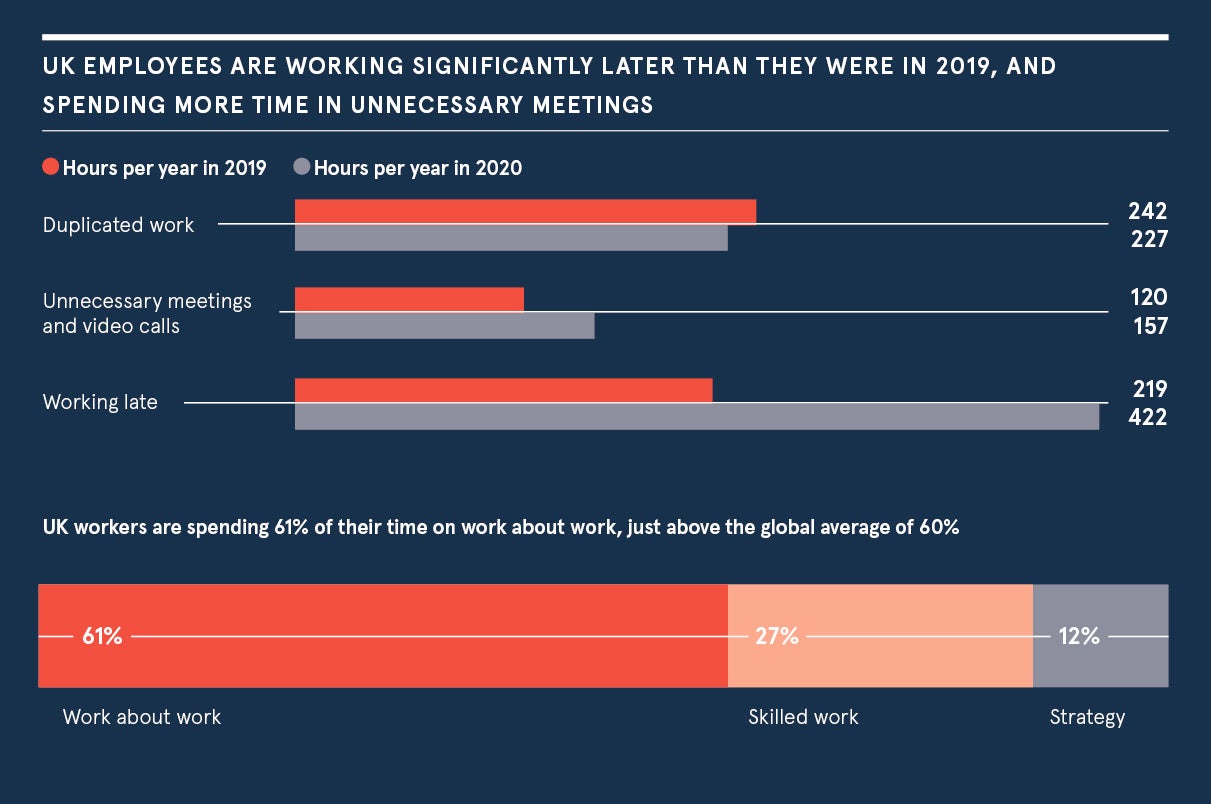
Content and communications tools may have enabled a reasonably seamless transition to remote working during the Covid-19 pandemic, but the rapid shift has also fueled distraction and disruption. Message pings and meetings are at an all-time high, while focus time has fallen by the wayside. In fact, employees are not only spending more time on less valuable work, but they are also more likely to be feeling disconnected and disengaged, according to Asana’s Anatomy of Work Index.
The research, which surveys thousands of knowledge workers around the world each year, found that UK employees are spending 61% of their time on what Asana calls “work about work”. This is work that does not add value, such as pinging co-workers for an update on a project, attending status meetings or piecing together an end-of-week report. This means remote workers are spending less than half of their time on the deep knowledge work they were actually hired for.
“With the mental toll of continuous lockdowns and the uncertainty of the pandemic, workers are finding it harder than ever to remain aligned and connected to their team,” says Simon O’Kane, Head of EMEA at Asana, a work management platform that helps teams orchestrate their work. “In the next phase of distributed work, leaders have an opportunity, and a business imperative, to take action and redefine how they keep their teams engaged, aligned and on track.”
With most companies looking to adopt a hybrid working model post-pandemic, companies face the difficult task of preparing their management to lead teams distributed across time zones and departments, with some in-office and others remaining remote. With some at home, some in the office, and most mixing and matching, organisations can expect new challenges around visibility and coordination, and the possible emergence of vastly different employee experiences at the same company.

“If they’re not careful, companies could see two tribes: those who work predominantly in the office versus those working predominantly at home,” says O’Kane. “What does that mean in terms of access to information? If there’s still an office culture where people get ad hoc updates at the coffee machine, home workers are going to be disadvantaged, and if home workers are more likely to be young parents, for instance, will that lead to new workplace inequalities? It’s a really complex topic and just underlines the need for task clarity and team visibility, regardless of where people work.”
For hybrid work to work, leaders must arm their employees with a single source of truth across the organisation. Asana achieves this by integrating with each department’s existing tools to streamline the tech stack, keeping employees productive, connected and engaged wherever they are working.
Earlier this month, Asana launched a number of new features to help employees eliminate distractions and boost productivity in a world of distributed work. In partnership with Vimeo, the new Video Messaging feature gives users the chance to connect async, eradicating unnecessary meetings. Enabling Asana users to send embed video notes within the real-time context of work, projects and tasks, to create short videos of themselves and/or their screens.
Transcripts of these videos will also be automatically available, allowing teams to exchange information in a silo-free and personalised way. Other features include ‘My Tasks’ a personal prioritisation system that combines an individual’s to-dos with their broader team’s work, and ‘Smart Calendar Assistant Integration’ with Clockwise, a leading smart calendar assistant, to easily schedule tasks into focus time without leaving Asana – helping employees manage their time to get meaningful work done.
“We make that coordination layer very democratised and open,” O’Kane adds. “You don’t need to be an expert – it’s intuitive and simple to use, and you can access it from home, on the move and in the office. Now with our newest features, it is even easier to reduce distractions and improve focus. With Asana, organisations can eliminate ‘work about work’ no matter which model they choose as we enter the hybrid age.”
For more information, visit asana.com
Promoted by Asana

Content and communications tools may have enabled a reasonably seamless transition to remote working during the Covid-19 pandemic, but the rapid shift has also fueled distraction and disruption. Message pings and meetings are at an all-time high, while focus time has fallen by the wayside. In fact, employees are not only spending more time on less valuable work, but they are also more likely to be feeling disconnected and disengaged, according to Asana’s Anatomy of Work Index.
The research, which surveys thousands of knowledge workers around the world each year, found that UK employees are spending 61% of their time on what Asana calls “work about work”. This is work that does not add value, such as pinging co-workers for an update on a project, attending status meetings or piecing together an end-of-week report. This means remote workers are spending less than half of their time on the deep knowledge work they were actually hired for.
“With the mental toll of continuous lockdowns and the uncertainty of the pandemic, workers are finding it harder than ever to remain aligned and connected to their team,” says Simon O’Kane, Head of EMEA at Asana, a work management platform that helps teams orchestrate their work. “In the next phase of distributed work, leaders have an opportunity, and a business imperative, to take action and redefine how they keep their teams engaged, aligned and on track.”





